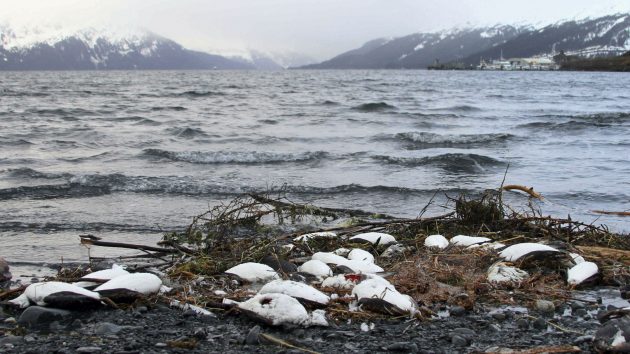Over just two days in early 2016, more than 6,000 penguin-like birds were found dead on the rocky beaches near Whittier, Alaska. Many of the dead birds, scientists observed, were clearly emaciated.
“It was pretty horrifying,” seabird biologist David Irons told a Canadian news outlet at the time. “The live ones standing along the dead ones were even worse.”
But the death of these 6,540 “common murres” wasn’t an isolated incident. Between the summer of 2015 and spring of 2016, tens of thousands of them washed up on Pacific beaches from Alaska all the way down to California in what scientists called an “astonishing” extreme mortality event for the species. (Other marine animal deaths and disappearances during the same time period—including additional seabird species, Pacific cod, sea lions, Guadalupe fur seals, and humpback whales—for the most part, went unexplained.)

Dead common murres lie washed up on a beach in Whittier, Alaska in 2016.
Mark Thiessen/AP
Something, experts quickly concluded, was causing the birds to starve to death, but until now, it was unclear what exactly was to blame. In a new paper, published Wednesday in the open-access journal PLOS ONE, more than 20 researchers link the murre die-off to a colossal mass of warm ocean water—colloquially, scientists called it the “Blob”—which spanned hundreds of miles across in the Pacific Ocean around the same time the dead murres carcasses were crowding the coasts. Marine heatwaves like the one that created the Blob have become more frequent in the past century and will likely worsen as Earth’s temperatures continue to rise with climate change.
One of North America’s most abundant seabirds, murres can fly more than 60 miles per hour and dive up to 650 feet in depth to catch schooling fish. The bird is built like a “jet fighter,” John Piatt, a research wildlife biologist at the US Geological Survey and the lead author on the study, tells Mother Jones. But to have all that explosive energy, the birds must find and consume a lot of food—about half their body mass per day. That high demand for energy is the murres’ “Achilles heel,” he says. Without food, murres can starve in as little as three days.
The birds’ food sensitivity makes them a good indicator of ocean health. Some murre deaths in any given season are normal, Piatt says, and die-offs have occurred during storms and other extreme warm-water events in the past. But what happened in the Pacific in 2015 and 2016, he says, was “beyond anything anybody’s ever seen.” Something in the ocean was way out of whack.
After years of collecting and analyzing data, researchers are finally starting to understand what went wrong. The new, sprawling study includes two major parts: In the first, the researchers estimate just how bad the mortality event was for the poor seabirds. Researchers considered nearly 5,800 beach surveys, public reports, and data from dozens of seabird rehab centers and concluded that approximately 62,000 dead or dying birds appeared on beaches between California and Alaska between the summer of 2015 and the spring of 2016. Not every dead bird washed ashore, of course, so the total number of birds killed is almost certainly larger. The researchers think the die-off could have taken the lives of around 1 million murres.
Alarmingly, they also documented 22 separate “breeding failures”—when a colony produces zero chicks—in the region during and after the die-off. As Piatt explains, one failure in any given year would have been unusual. “To have repeated failures at large, important colonies?” he says, “That’s unprecedented.”
In part two of the study, the scientists argue, based on their own research combined with data presented in dozens of other studies, that the heatwave likely caused the birds to starve. The higher temperatures, their findings suggest, reduced the size and fat of the murre’s prey and increased competition from larger fish species like Pacific cod, walleye pollock, and arrowtooth flounder, which eat the same small fish on which the murres rely. In fact, a 2015 study from researchers at the National Oceanic and Atmospheric Administration predicted that a two-degree increase in ocean temperatures in the Gulf of Alaska (almost exactly what scientists saw in the case of the Blob) would cause the murres’ competitors to increase their food consumption by up to 70 percent. Simply put, warmer water means smaller prey—and more competition.
Tim Birkhead, a professor of behavioral ecology at the University of Sheffield in England, who has studied common murres for decades and was not involved in the study, tells Mother Jones he was “horrified” by the results. “Seabird populations across the world have just about halved in the last three or four decades. Here is yet another major blow.” Birkhead was “impressed” by the study, he says, because it was comprehensive and the authors were “careful” and “honest” about their findings. “They did it without any bullshit.”
The evidence is convincing in its simplicity (“parsimonious,” as Piatt calls it) but it is still only a piece of the puzzle. The conclusions, though well-supported, are still only hypotheses for what the researchers think explain the die-off. The ocean is vast and complex, and not every heatwave will have the same effect. Piatt hopes that others will continue to study the phenomenon, perhaps with computer modeling. “Models could be useful in helping us predict which species are going to take a hit [from future heat waves],” he says. “Now we see it’s murres, but we could plug in more species into the model. We can plug more fish into the model. What happens if it’s three degrees—or four degrees?”
As devastating as it was, the heatwave that caused the Blob was only categorized as “severe.” Marine heatwaves can be classified anywhere from “moderate” to “extreme” (for instance, the one that hit the waters off Western Australia in 2011 that caused widespread coral bleaching and fish deaths). And these events will likely only get worse. With climate change, the study’s authors warn, “the expected intensity, frequency, spatial extent and duration of heatwaves by the end of the twenty-first century may well cause unprecedented and irreversible changes to marine ecosystem functionality and stability.”















